
By David Eskenazi and Steve Rudman
Before 1984, the NCAA Men’s Basketball Tournament never inspired office pools and side wagers or compelled network television to splurge billions of dollars for the privilege of providing wall-to-wall coverage. Before 1984, “Selection Sunday” didn’t exist. Nobody talked about the Sweet Sixteen and the Elite Eight, much less seeds and bracketology.
The NCAA Tournament more accurately resembled a little jig than a Big Dance. Not that the tournament lacked entertainment or athletic value, but it didn’t have cities all across America stumbling over themselves to host it. It did have tournament tickets – even Final Four tickets – often going unused.
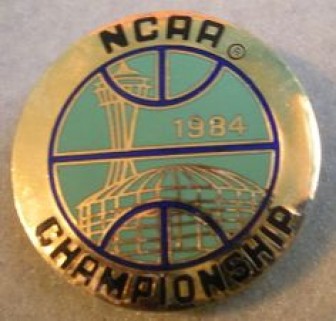
But 30 years ago, when Seattle was through with it, the NCAA Tournament featured a moniker known everywhere. “March Madness” had become a month of delightful lunacy that would evolve into one of the fattest cash cows in the annals of games-playing.
The idea that Seattle might bid for a Final Four did not come from anyone on what became known as the Seattle Host Committee, although its members, including Kingdome executives Ted Bowsfield and Bill Sears and local entrepreneur Bob Walsh, brought the spectacle to fruition.
The idea for the Seattle event first dawned on a future stockbroker from Bellevue named Mike Maruhashi, more or less a Kingdome gopher in those days working in the employ of Sears, a former Seattle U. and Seattle Rainiers public relations maven who did similar work for the Kingdome. When Maruhashi pitched the idea to Sears, Sears liked it and acted.
As a college basketball town, Seattle did not exactly rival Raleigh-Durham, Lexington, Lawrence or even Tucson, but it had the only domed stadium on the West Coast that included a basketball configuration, and it could accommodate 40,000 fans, far more than most Final Four venues of the day.
Seattle not only had a big indoor stadium, the Final Four had not been played on the West Coast since 1975, the year UCLA Coach John Wooden won his 10th and final national championship in San Diego.

Sears took Maruhashi’s idea to his boss, Bowsfield, who brought University of Washington athletic director Mike Lude and Hartley Kruger of the Seattle Visitors and Convention Bureau into the conversation. Loosely designating themselves the “Seattle Host Committee,” they made their pitch to the NCAA during Final Four site selection meetings in Salt Lake City in 1978, two years after the Kingdome opened.
They hoped to land the 1983 Final Four, but were willing to settle for anything. Seattle had not hosted any NCAA Tournament games since 1952, when University of Washington athletic director Harvey Cassill had a lot of sway with the NCAA.
A former insurance man, Cassill arrived at UW in 1946 and took it upon himself to remake the school’s athletic programs with the intent of turning Washington into what he described as “the Notre Dame of the West.” He sought out big-name coaches, worked to improve UW’s athletic facilities and made it his mission to bring major NCAA events to the campus.
He made successful bids for the 1947 NCAA swimming and diving shampionships, 1951 NCAA outdoor track and field championships, and 1952-53-54 NCAA tennis championships. Cassill also persuaded the NCAA to hold the 1949 Final Four in Washington’s Hec Edmundson Pavilion.
Final Fours In Seattle
| Year | Winner | Coach | MVP | Rest Of Field |
|---|---|---|---|---|
| 1949 | Kentucky | Adolph Rupp | Alex Groza | Okla. A&M, Illinois, Ore. St. |
| 1952 | Kansas | Phog Allen | C. Lovellette | St. John’s, Illinois, S. Clara |
| 1984 | Georgetown | John Thompson | Pat Ewing | Houston, Kentucky, Virginia |
| 1989 | Michigan | Steve Fisher | Glen Rice | Seton Hall, Duke, Illinois |
| 1995 | UCLA | Jim Harrick | Ed O’Bannon | Arkansas, N. Car., Okla. St. |
In those days, the entire tournament included only eight teams and, following regional rounds in Kansas City’s Municipal Auditorium and New York’s Madison Square Garden, Kentucky, Oklahoma A&M, Illinois and Oregon State battled in Seattle in what was then called the “East-West Finals. ” Kentucky won, defeating Henry Iba’s Oklahoma A&M squad, 46-36.
Three years later, with the field having doubled to 16 teams, the Final Four was again held at Hec Edmundson Pavilion, Kansas defeating St. John’s in the championship game. After Cassill left UW, a casualty of a 1956 slush-fund scandal involving illegal payments to football players, the NCAA stayed away from Seattle until Bowsfield and Sears made their pitch in 1978.

Following their presentation, Bowsfield and Sears lounged in the coffee shop at the Hotel Utah when Tom Jernstedt, assistant executive director of the NCAA, gave them the good news: Seattle had been awarded the 1984 Final Four. None of the three men had any idea that the Final Four would never be the same.
Bowsfield and Sears, in fact, didn’t even know what to do with the Final Four once they acquired it. But they knew who would know: Walsh, in conjunction with Bowsfield, had developed a floor and seating configuration for Seattle SuperSonics games at the Kingdome, and operated a company that produced and promoted numerous sports projects, including the popular Emerald City Marathon.
When Bowsfield presented Walsh with the opportunity to become involved in the Final Four, Walsh recognized at once that producing promotional and hospitality events surrounding the Final Four would significantly enhance the profile of his own company and give Seattle a chance to showcase its special attractions.
Walsh and his staff soon envisioned the most elaborate Final Four ever staged, a celebration to exceed all previous basketball celebrations, an event that would include non-stop parties, boat cruises in Puget Sound, salmon barbeques and limo service for NCAA officials and VIPs. The most important VIPs would be greeted at Sea-Tac Airport with bands and cheerleaders and lavished with gifts.
All VIPs would have access to a new Mercedes or BMW and each would be assigned a driver. A shuttle system would be set up through a transportation committee so that VIPs, media and guests could get quickly and effortlessly to the Kingdome, around town, and back to their hotels, which would include Final Four information centers. Volunteers would be recruited to serve as guides and hosts.

Before 1984, no host city had created a local organizing committee to exploit the possibilities that a Final Four presented. But the Seattle Host Committee created one to ensure that the 1984 Final Four would become a four-day festival to remember.
For the first time in the event’s history, a host city’s downtown would be festooned with pennants, banners and welcoming billboards. Also for the first time, bands and cheerleaders would be positioned strategically on city streets to add to the gala nature of the occasion. Sears had this idea: paint a huge yellow-brick road just outside the Kingdome. The CBS cameras would find “The Road To The Emerald City” irresistible.
Many of the Seattle Host Committee’s ideas for the 1984 Final Four hatched from the debris left by other host cities, especially Albuquerque, site of the 1983 Final Four. Although that event concluded with one of the greatest games in NCAA tournament history, North Carolina State’s 54-52 upset of the University of Houston, nicknamed Phi Slama Jama, the surrounding aspects had been fraught with problems.
Transportation was a mess. A coaches’ party in Albuquerque’s Old Town featured a less-than-palatable menu of cold barbequed beans, hot dogs and draft beer served outside in penguin weather. Albuquerque officials offered no entertainment of consequence and had nothing to keep fans and officials occupied between sessions of the tournament.
Seattle Host Committee members recognized they had a great opportunity to create not only a seminal event in the history of the Final Four, but in Seattle sports history as well.

Oddly, the committee’s biggest detractor became the Seattle Chamber of Commerce, unimpressed that 30,000 Final Four visitors, loaded with cash, plastic and enthusiasm, would pump millions into the local economy. So the Chamber did not support the event.
Determined to organize the greatest Final Four without a Chamber endorsement, the Seattle Host Committee privately raised and spent more than $1 million. The effort paid off.
“The people in Seattle literally rewrote the book on how to host the Final Four,” Rick Baker told The Seattle Post-Intelligencer. Baker ran the 1986 Final Four in Dallas and eventually became executive director of the Cotton Bowl. “It was a whole new era. Without a doubt, Seattle started some new things that other cities which followed had to be cognizant of or they were going to look pretty foolish.”
“All at once in Seattle, the Final Four became March Madness,” said Jim Host, whose company, Host Communications, performed broadcasting and other services for the NCAA. “Before Seattle, we never had billboards welcoming the Final Four into town. We never had department stores decorated, merchandise stands on the streets, parties at the hotels, or special VIP accommodations.
“The whole scope of what is now March Madness dramatically expanded at that Final Four in Seattle. After Seattle, everybody else who hosted a Final Four had to copy what Seattle did. Walsh was the first guy who actually went in with a local organizing committee and tried to figure out ways to make things better, and he succeeded brilliantly.
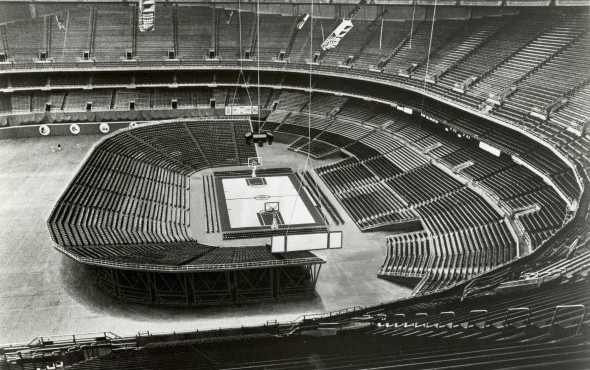
“People don’t really understand that the Final Four did not start to take off as a national phenomenon until the event got to Seattle. But people who have been connected with it as long as I have know that’s when it took off. Before 1984, the Finally Four was really a non-event. Today, it’s a spectacle. That Final Four caused everybody I know to look at Seattle as a hugely progressive city.”
Of course, it did not hurt that Seattle enjoyed a burst of glorious weather during Final Four weekend, or that two of college basketball’s most touted big men, Patrick Ewing of Georgetown and Akeem (he was not yet Hakeem) Olajuwon of Houston, met for the first time.
Kentucky and Virginia joined the Hoyas and the Cougars that weekend in the Kingdome. Coached by Joe B. Hall, the Wildcats featured three future first-round NBA picks in Sam Bowie, Kenny Walker and Mel Turpin. A No. 7 seed when the tournament began, the Cavaliers had a future No. 1 of their own, 6-foot-11 sophomore Olden Polynice.
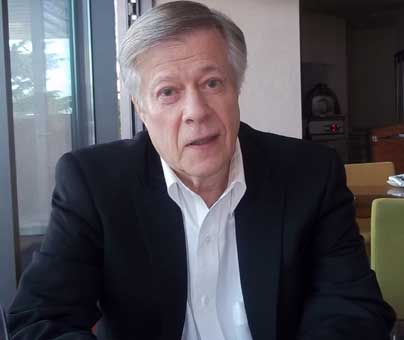
In addition to Olajuwon, Houston, coached by Guy Lewis, had a fine point guard in sophomore Alvin Franklin and would have been the heavy favorite to win the tournament if Clyde Drexler hadn’t left for the NBA following the 1982-83 season.
Georgetown coach John Thompson surrounded Ewing with David Wingate, Reggie Williams, Michael Graham and guard Fred Brown (no relation to the Sonic of the same name), whose errant pass two years earlier in the final against North Carolina had left the Hoyas one basket short of a title.
After Houston defeated Virginia 49-47 in one national semifinal and Georgetown destroyed Kentucky 53-40 in the other, Ewing and Olajuwon took the court Monday, April 2, in front of 38,471.
Olajuwon, the No. 1 overall pick in the 1984 NBA draft, subsequently played 15 pro seasons, made 12 All-Star teams, won the 1994 MVP award and twice was MVP of the NBA Finals. He scored 26,946 points and entered the Basketball Hall of Fame in 2008, the same year as Ewing, the No. 1 overall pick in the 1985 draft and an 11-time All-Star who scored 24, 815 points in 17 seasons.
Their first-ever matchup failed to pan out in the manner spectators imagined it would. Olajuwon was in early foul trouble, sat out long stretches and finished with 15 points and nine rebounds. Although Franklin scored 21 points and dished nine assists, Georgetown’s depth proved too much. Ewing had a modest contribution of 10 points, but Williams tallied 19, 13 in the second half, while Wingate added 16 and Graham 14. Georgetown won 84-75 in the final NCAA Tournament to feature a 53-team field (the field has included 64 teams, not counting play-ins, since 1985).
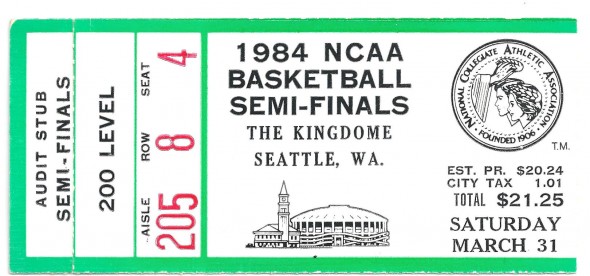
The Seattle Host Committee impressed the NCAA sufficiently enough that Seattle was awarded the 1989 Final Four Seattle practically before the 1984 event ended. The NCAA then awarded Seattle a third Final Four for 1995. There might have been more, but the 2000 implosion of the Kingdome left Seattle without a facility suitable to the NCAA’s needs.
Since the demolition of the Kingdome, the Final Four has been held almost exclusively in large domed facilities, including the RCA Dome in Indianapolis four times with another scheduled there in 2015. In fact, the Final Four has not been held in an “arena” since 1996, and likely never will again, as Mark Lewis, NCAA executive vice president for championships, told ESPN in 2012.
“None of the cities where we play our championship is named New York, Boston, Los Angeles, Chicago or Miami,” Lewis said. “We don’t play on a campus. We play in professional football arenas.”
Given that requirement, Chris Hansen’s proposed 18,000-seat basketball/hockey facility in Sodo wouldn’t cut it as a Final Four venue, meaning that Seattle’s time as a championship hosting site has come and gone, although KeyArena will host a men’s regional March 20-22, 2015. But the city had, to paraphrase former Mariners GM Pat Gillick, “three kicks at the cat,” none more significant than in 1984 when it turned the tournament into March Madness.
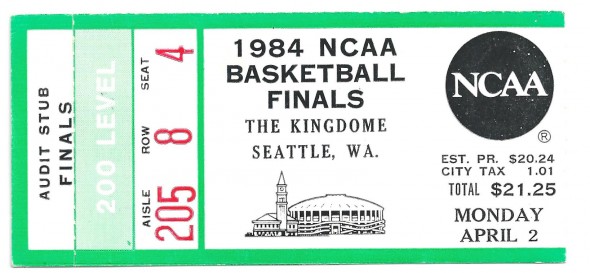
—————————————
Many of the historic images published on Sportspress Northwest are provided by resident Northwest sports history aficionado David Eskenazi. Check out David’s Wayback Machine Archive. David can be reached at (206) 441-1900, or at seattlesportshistory@gmail.com

6 Comments
This was my biggest reservation about supporting the construction of CenturyLink Field: no more Final Fours. But those pretty much went by the wayside when Bob Walsh got out of sports management. But at the very least when the Kingdome was around Seattle was always in the discussion for one, as well as other large scale athletic events. Great to see that the Key will be hosting a regional. At some point the NCAA is going to have to realize the 1980s are dead and it isn’t so much how many you pack into the venue but rather how many you reach digitally, i.e. radio, TV and the internet.
What is good for the NCAA is also a consideration. The last time the FF was on the West Coast was when it was in Seattle in 1995. The next closest have been in Indianapolis in 2006, Houston in 2011 and San Antonio in 2004 and 2008. Saying Indiana and Texas are in the West is like saying Spokane is out on the coast. Considreing that the balance of power, IMHO, in college basetball is East of the Mississippi it could help NCAA basketball if they went West occasionally.
I still have my program for the Houston/Georgetown game. I remember watching that game thinking I was watching a pro game, the players were so talented. It’s no wonder so many of them went pro. And I was very happy for Fred Brown to get a shot at redemption after his errant pass to James Worthy against North Carolina the previous season. I hope someday the Pacific NW gets an opportunity to start some new history in college basketball.
Thanks for the comment, but we did not “get out” of sports management, we were forced out by a very bureaucratic Seattle Sports Commission who also killed any incentive for other entrepreneurs. They were upset that we didn’t get permission from of Seattle’s old leaders for the Goodwill Games. And now, after we have urged the Sports Commission to bid for the 2024 Summer Olympics, which 55% of the residence of the state support, they have informed the USOC Seattle doesn’t want the event. It’s a long story but there is no question in my mind and that of many experts that Seattle could be the next host. The NCAA events we brought to the city deposited about $500 M into the area; the Goodwill Games about $300+ million.
And there is a new pool in Federal Way.
The Olympics would set this city up for the next century. Of course there would be problems, many problems…..but the risk is worth it.
And, since there was no discussion on how the new football stadium (which is a fantastic facility) should be built, a roof was left off. The NCAA planned to have the Final Four in Seattle every four to five years until the roofless building was constructed, meaning we have lost about one half billion dollars, incredible community pride and international visibility just on March Madness. The people of Seattle deserve better. Seattle ranked #4 in the US in 1989 in sports events, today it ranks 48th.
Not expecting a response from you Bob, but appreciate it!
When I say that you and your people got out of sports management I was speaking in general terms to get to my point about the NCAA. Steve Rudman did an excellent column here on Sportspressnw on your history in Washington sports and your contributions and gave many details that I’m familiar with but did not get into here. I agree that Seattle does not support athletic events as they used to. If they did bid on the Olympics I believe the arena issue that’s been the hub of NBA debate would not be an issue. The Olympics would have made a new arena or a Key Arena renovation happen. Possibly down the road when city leaders see what the Olympics has done for Vancouver and Whistler maybe they’ll be more receptive to attracting more sports events.
I’m hoping that the new arena, assuming it becomes a reality, will be enough to bring in a Final Four again. I have great memories of the three you were responsible for bringing to our city and want to see that happen again.
Thank you. The Final Four will never return to Seattle until the city has a 60,000 seat indoor arena. The proposed basketball and/or hockey arena is much too small. The days of Final Fours or other major big indoor events were blown up with the Kingdome!
Agreed. The Kingdome never should’ve been torn down. Renovated? Absolutely, but not imploded. Purists hate domed stadiums, but you can sure do a lot of things with them (and stay warm and dry in the process).
I have no bad memories of the Kingdome. Only good ones. Ditto with the Key. I have at least one souviner from all the Seattle Final Fours. I can understand building Safeco Field but I was fine with the Hawks in the Kingdome. Prefer the Sounders at the CLink. I suppose the Hawks would say the same thing the NBA says about the Key: they make more profit if they have their own faciltiy instead of playing in a county owned facility. That’s always what it comes down to, profit above all else.. And as always it’s the sport fans who ultimately lose out.